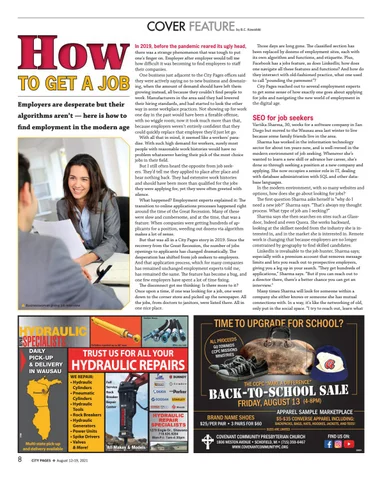How
TO GET A JOB
Employers are desperate but their algorithms aren’t — here is how to find employment in the modern age
▲ Businesswoman giving job interview
COVER FEATURE
by B.C. Kowalski
In 2019, before the pandemic reared its ugly head, there was a strange phenomenon that was tough to put one’s finger on. Employer after employer would tell me how difficult it was becoming to find employees to staff their companies. One business just adjacent to the City Pages offices said they were actively saying no to new business and downsizing, when the amount of demand should have left them growing instead, all because they couldn’t find people to work. Manufacturers in the area said they had lowered their hiring standards, and had started to look the other way in some workplace practices. Not showing up for work one day in the past would have been a fireable offense, with no wiggle room; now it took much more than that, because employers weren’t entirely confident that they could quickly replace that employee they’d just let go. With all that in mind, it seemed like a workers’ paradise. With such high demand for workers, surely most people with reasonable work histories would have no problem whatsoever having their pick of the most choice jobs in their field. But I still often heard the opposite from job seekers. They’d tell me they applied to place after place and hear nothing back. They had extensive work histories and should have been more than qualified for the jobs they were applying for, yet they were often greeted with silence. What happened? Employment experts explained it: The transition to online applications processes happened right around the time of the Great Recession. Many of these were slow and cumbersome, and at the time, that was a feature. When companies were getting hundreds of applicants for a position, weeding out dozens via algorithm makes a lot of sense. But that was all in a City Pages story in 2019. Since the recovery from the Great Recession, the number of jobs openings to applicants has changed dramatically. The desperation has shifted from job seekers to employers. And that application process, which for many companies has remained unchanged employment experts told me, has remained the same. The feature has become a bug, and one few employers have spent a lot of time fixing. The disconnect got me thinking: Is there more to it? Once upon a time, if one was looking for a job, one went down to the corner store and picked up the newspaper. All the jobs, from doctors to janitors, were listed there. All in one nice place.
Those days are long gone. The classified section has been replaced by dozens of employment sites, each with its own algorithm and functions, and etiquette. Plus, Facebook has a jobs feature, as does LinkedIn; how does one navigate all these features and functions? And how do they intersect with old-fashioned practice, what one used to call “pounding the pavement”? City Pages reached out to several employment experts to get some sense of how exactly one goes about applying for jobs and navigating the new world of employment in the digital age.
SEO for job seekers
Vartika Sharma, 30, works for a software company in San Diego but moved to the Wausau area last winter to live because some family friends live in the area. Sharma has worked in the information technology sector for about ten years now, and is well-versed in the modern environment of job seeking. Whenever she’s wanted to learn a new skill or advance her career, she’s done so through seeking a position at a new company and applying. She now occupies a senior role in IT, dealing with database administration with SQL and other database languages. In the modern environment, with so many websites and options, how does she go about looking for jobs? The first question Sharma asks herself is “why do I need a new job?” Sharma says. “That’s always my thought process. What type of job am I seeking?” Sharma says she then searches on sites such as Glassdoor, Indeed and even Quora. She works backward, looking at the skillset needed from the industry she is interested in, and in the market she is interested in. Remote work is changing that because employers are no longer constrained by geography to find skilled candidates. LinkedIn is invaluable to the job hunter, Sharma says; especially with a premium account that removes message limits and lets you reach out to prospective employers, giving you a leg up in your search. “They get hundreds of applications,” Sharma says. “But if you can reach out to a director there, there’s a better chance you can get an interview.” Many times Sharma will look for someone within a company she either knows or someone she has mutual connections with. In a way, it’s like the networking of old, only put in the social space. “I try to reach out, learn what
TIME TO UPGRADE FOR SCHO SCHOOL? ALL PROCEEDS
2365
DAILY PICK-UP & DELIVERY IN WAUSAU
Multi-state pick-up and delivery available
8
CiTY PAGES
TRUST US FOR ALL YOUR
HYDRAULIC REPAIRS WE REPAIR: • Hydraulic Cylinders • Pneumatic Cylinders • Hydraulic Tools • Rock Breakers • Hydraulic Generators • Power Units • Spike Drivers • Valves & More!
August 12-19, 2021
Full Service Rock Breaker Repair Center
GO TOWARDS S CCPC MISSION S IE TR IS MIN
THE CCPC “MAKE A DIFFERENCE”
ALE HOOL S BACK-TO-SCST 13 (4-8PM) FRIDAYY, AUGU
BRAND NAME SHOES
$25/PER PAIR • 3 PAIRS FOR $60
APPAREL SAMPLE MARKETPLACE
$5-$35 CONVERSE APPAREL INCLUDING:
BACKPACKS, BAGS, HATS, HOODIES, JACKETS, AND TEES! SIZES ARE LIMITED
COVENANT COMMUNITY PRESBYTERIAN CHURCH All Makes & Models
1806 WESTON AVENUE • SCHOFIELD, WI • (715) 359-6467 WWW.COVENANTCOMMUNITYPC.ORG
FIND US ON: 59834



